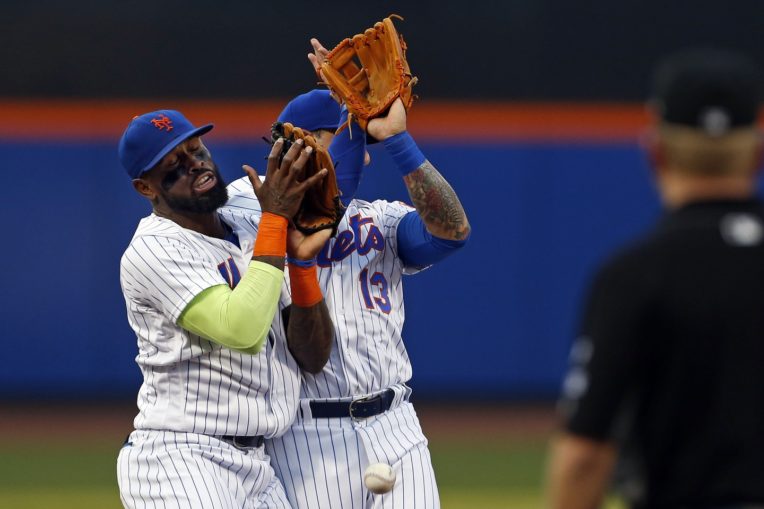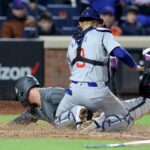
Of the Mets’ many deficiencies last season, defense may have been the most underlooked.
Whereas the team’s deficiencies at third base, in the bullpen, and in the rotation have received varying degrees of scrutiny from the front office and fans alike, the fielding aspect of the team has gone somewhat under the radar. Last year, the Mets held the tenth-lowest team fielding percentage in the NL, committed the eighth-most errors, and featured some of the worst individual defenders in all of baseball.
There are many question marks on defense this season. And knowing the Mets, the answers following those question marks are almost never good. That said, here’s a position-by-position breakdown the Mets’ defense — which might not be so bad, if all goes well.
Not that all will go well, though.
Catcher: Travis d’Arnaud improved by leaps and bounds defensively last season — which is to say, he was slightly above average. Having saved -28 defensive runs from 2013-16, d’Arnaud was at an even zero in 2017. His dWAR also stood at 2.5 — the second-best mark of his career. His two passed balls last season also ranked among the lowest in the majors, although Fangraphs did have him at -4 stolen base runs saved above average.
Verdict: d’Arnaud is not an awful defender — but he’s certainly not the best, either.
First base: Adrian Gonzalez is a four-time Gold Glove Award winner, and won the award as recently as 2014. But he’s come on hard times as of late: His dWAR has been negative in each of the last two seasons, at -0.7 and -0.5 respectively, and he was two defensive runs below average last season — the first time he was negative in that category since 2010. Since 2006, Gonzalez is second to just Albert Pujols in defensive runs saved among first baseman, so hopefully there’s still some gas left in his tank. But last season doesn’t make things look too promising for 2018.
Verdict: Unclear, but trending in the wrong direction.
Second base: Asdrubal Cabrera is perhaps the worst defensive second baseman in baseball. He posted a -3.4 dWAR last season, which would have made him the second-lowest among qualified second basemen if he had enough innings to qualify. Cabrera made 11 errors in just 386 defensive innings last year. Had he played 1,000 innings, he’d be on pace for about 30 — which would have been the most in the league.
The Mets were reportedly hesitant to sign Todd Frazier over a capable second baseman because of Cabrera’s defensive concerns. And looking at the numbers, it’s not hard to see why.
Verdict: Close your eyes.
Shortstop: Assuming Amed Rosario can hold the job, the Mets should be in good hands. He saved one defensive run above average last season, and posted a 0.3 dWAR in just 45 games of action. At just 22 years old, one would expect Rosario to grow even more this season.
Verdict: Good… We hope.
Third Base: Todd Frazier has posted a positive dWAR in six of his seven big-league seasons, but that number has never eclipsed 1.0 — it was at 0.8 last year. Frazier did, however, save a career-high ten defensive runs above average last season while playing third base. It’ll be nice for the Mets to have a regular third baseman for a change, as opposed to the revolving door that has occupied the position for the last three years.
Verdict: Frazier is above-average, but not by much.

Left field: Yoenis Cespedes boasts one of the game’s best arms out of the outfield; and he saved two runs above average in left last season. But his range has always been questionable: He saved -0.3 range runs above average last season. Hopefully Cespedes will be able to put his quad issues behind him, and play his true position of left field — which he has seldom done while fully healthy as a Met.
Verdict: Not bad, if Cespedes’ quad holds up.
Center field: It will certainly depend on who starts in center with Juan Lagares being one of the best in baseball (15 DRS in only 566 innings last year) and Brandon Nimmo (-3 DRS in limited time in CF). The combo could be in center for only a short period with the target date for Michael Conforto‘s return at Mat 1.
Conforto’s a solid corner outfielder, who is playing sort of out-of-position in center. The team doesn’t really have much of a choice at this point but to play Conforto there. He saved four runs below average last season, but posted a 0.4 defensive WAR. He’ll be sidelined until May due to the freak shoulder injury he suffered mid-swing last season, but hopefully he’ll be able to come back on or close to schedule.
Verdict: You could do worse and have a great late inning replacement.
Right field: The analytics indicate that Jay Bruce is a better right fielder than you’d think from watching him. He saved 0.6 runs above average last season, and posted a positive dWAR while he was with the Mets. He’s no Jason Heyward, but he’s not terrible either.
Verdict: Not as bad as you’d think.
Overall, the Mets should benefit defensively from having Amed Rosario full-time instead of Jose Reyes, and Todd Frazier instead of a revolving door of Reyes, Wilmer Flores, Asdrubal Cabrera, Eric Campbell, Ty Kelly, and whoever else happened to show up on a given day. Adrian Gonzalez could help out big-time as well, if he starts playing somewhere close to the way he did just a few years ago. So in this department, the Mets have improved, albeit only slightly. 













